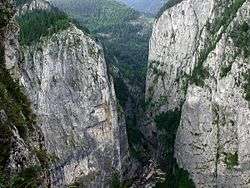Please tell us which country and city you'd like to see the weather in.

Bicaz Gorge
Coordinates: 46°48′43″N 25°49′08″E / 46.81198°N 25.81894°E / 46.81198; 25.81894
The Bicaz Gorge (Romanian: Cheile Bicazului, Hungarian: Békás-szoros) is a gorge in Romania, located in the north-east part of the country, in Neamţ and Harghita counties; it is part of the Cheile Bicazului-Hășmaș National Park.
The gorge was excised by the waters of Bicaz River and it serves as a passageway between the Romanian provinces of Moldova and Transylvania.
It is a noted location to see the wallcreeper, an uncommon cliff-dwelling bird.
The road along the 8 kilometres of ravines, often in serpentines with rock on one side and a sheer drop on the other, is one of the most spectacular drives in the country. Also within the gorge is Lacul Roşu (the Red Lake), with its traditional cabins, hotels, and its famous lake (situated at 980m altitude) caused by a landslide in the 19th century.
Cheile Bicazului is one of the main rock climbing sites in Romania.



See also

Bicaz
Bicaz is a town in Neamţ County, Romania situated in the eastern Carpathian Mountains near the confluence of the Bicaz and Bistriţa Rivers and near Lake Bicaz, an artificial lake formed by the Bicaz Dam on the Bistriţa. Bicaz used to be a border town until 1918. Six villages are administered by the town: Capşa, Dodeni, Izvoru Alb, Izvoru Muntelui, Potoci and Secu.
Economy
Before the construction of the dam (1950–1960) the settlement was just a mountain village in Eastern Carpathians where the main economic activity was timber harvesting. By tradition, the tree trunks were linked together, forming a raft (pluta); a raftman (Romanian: plutaş) used to drive the raft on the Bistriţa river downstream to wood processing facilities in Piatra Neamţ.
Building the dam created also a horizontal industry: two cement and aggregate plants were built in Bicaz proper and nearby Tașca. This, together with the construction of a hydroelectric power plant in Stejaru (10 km to the east) triggered a relative economic boom during the communist period.
Radio Stations - Bicaz_Gorge
SEARCH FOR RADIOS
Podcasts:

